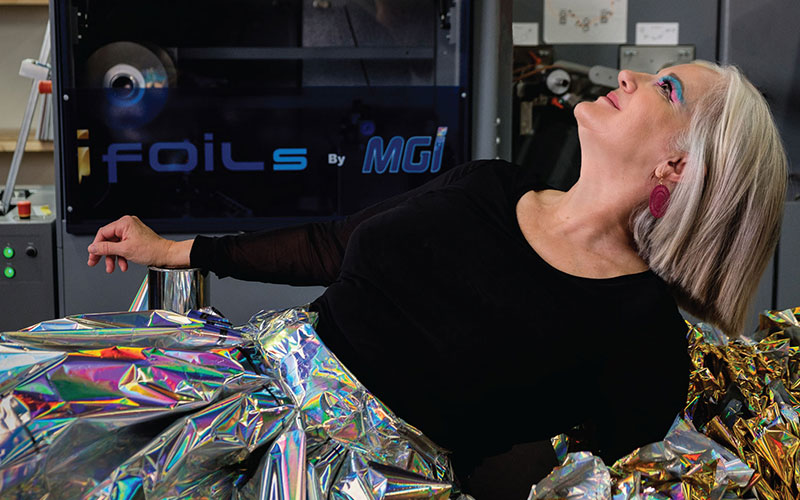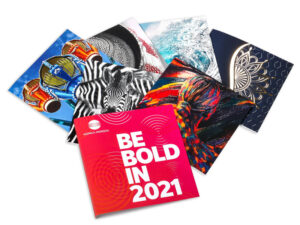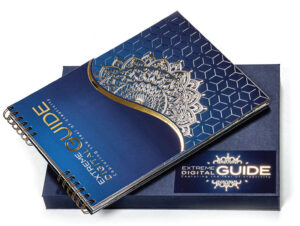
By Christine Yardley, Print Panther
It’s hard to imagine a post-pandemic world, but history proves innovation and creativity prevail during times of crisis. The print industry is no exception to this. From direct mail to packaging, the future has changed. Tactile, meaningful and impactful print will be a clear winner coming out of a digitally saturated period of history. We all want to touch again and that will keep embellished print at the forefront.
Christine Yardley took extreme branding and her love for foil to a new level with her dress, skirt and boa made of MGI Matte Gold and Crown Roll Leaf Holographic Gold and Silver Foil. Kudos to Cary Mann and Jeff Yardley for art direction and creation. Photography: Jenn Grachow. The boa was a labor of love that took 10+ hours to stitch together. All foil used was remnants. No new rolls were harmed!
Everyone recognizes it. Brands have become dislocated from their consumers or customers. COVID-19 has exacerbated this. Everyone talks of the online experience, but what is the physical experience? What really is an online experience?
More importantly, has the perception of an online presence become so important that the people who create the connections between the brands and their customers forgotten how to make it physical? Have we forgotten how to create a physical experience?
Remember the days of shelf wobblers? Most likely many of you do not, but brands took a physical presence in stores to reach out to their existing and potential customers. They attempted to talk to them through a clever physical call out. We’ve come a long way – or have we? Is simply clicking on a button on a phone or laptop the same thing? Is a brand’s message delivered in a “pop up” or website within a website creating the experience most brands would seek? For most luxury brands, the answer would be a resounding no. They want every touchpoint with their customers to ooze the presence of their brand and the specialness of their customers. But what about more everyday brands?
 For them, the truth is – in many cases – they are becoming disintermediated from their customers, (i.e., they exist on other brands platforms). They now work overtime on their relationships with their customers/consumers. But how to get personal?
For them, the truth is – in many cases – they are becoming disintermediated from their customers, (i.e., they exist on other brands platforms). They now work overtime on their relationships with their customers/consumers. But how to get personal?
For a lot of brands, getting something physical into the hands of their customers may not be feasible ahead of the customer receiving their product. But for many brands, a touch, feel and smell message can make the difference between a converted buyer, employee or even a possible investor and an unengaged consumer.
We know sensorial experience matters. It is why the Grand Hyatt hotels spray their reception areas and rooms with a particular fragrance. And let’s face it – we all have lost the sensorial experience we once enjoyed in these COVID-19 times. But that means it is more important than ever to offer something physical, tangible and, above all, sensorial.
The question for our industry is: Do brands and the people who serve them in creating their customers’ relationships understand what we can do? Opening a printed, laminated, foiled, varnished and personalized physical message can be so powerful – but do the brand managers and agencies that serve them understand what new potential exists?
As an industry, we need to rise to this challenge. We have the opportunity to legitimately help brands connect with their customers and have their customers feel special and cared for by the brands they choose, but we must show them the way.
 I encourage my fellow embellishers in the industry to create enticing samples of what your capabilities are and what is possible with foil, specialty UV coatings, laminates and more. You can see a dramatic example of this in the production of the Konica Minolta/MGI Extreme Digital Guide that we produced in 2020 that won Best of Show Honorable Mention in the FSEA Gold Leaf Awards. More of this type of work is what we need to showcase our capabilities.
I encourage my fellow embellishers in the industry to create enticing samples of what your capabilities are and what is possible with foil, specialty UV coatings, laminates and more. You can see a dramatic example of this in the production of the Konica Minolta/MGI Extreme Digital Guide that we produced in 2020 that won Best of Show Honorable Mention in the FSEA Gold Leaf Awards. More of this type of work is what we need to showcase our capabilities.
Let us not get stuck in the now, but think about the way in which we can innovate our own industry to make brands personal. We have the technology like never before and we have to embrace it. Above all, we need to make the brand managers, and the people who help promote those brands, understand what a difference these innovations can make.

